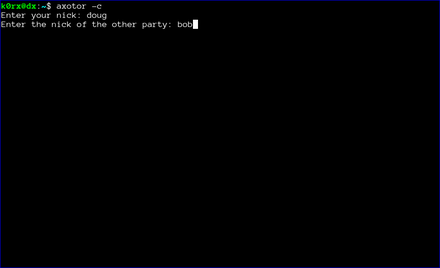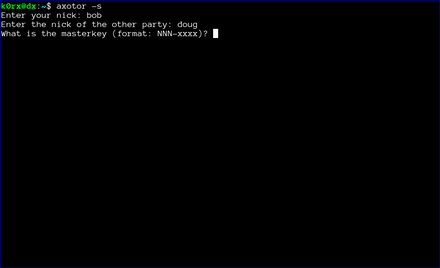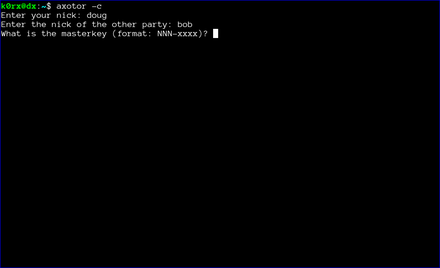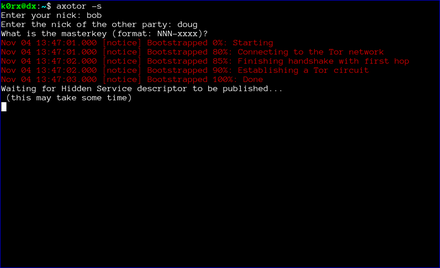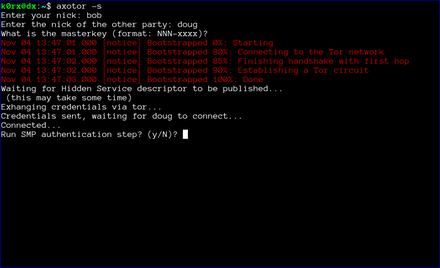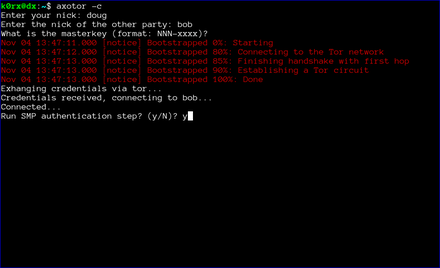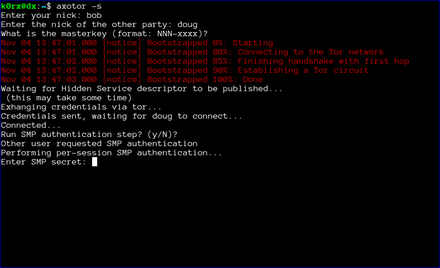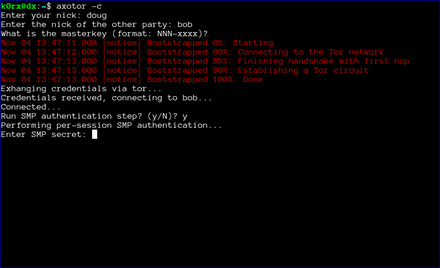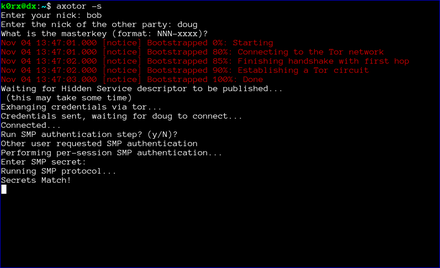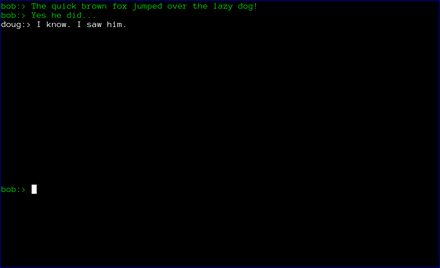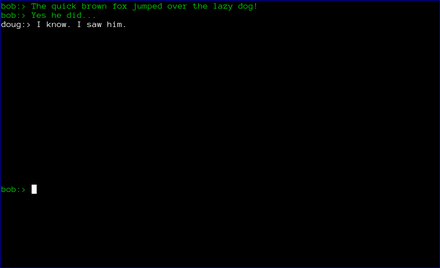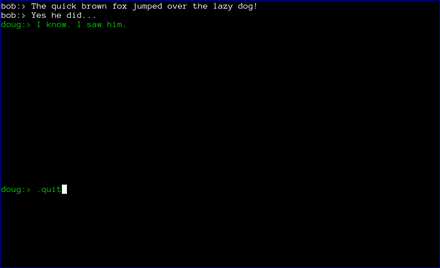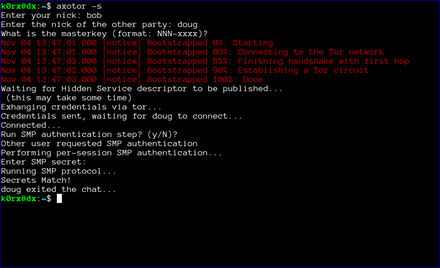Metadata-less Encrypted Chat Using Axolotl+Tor
Metadata-less axotor
axotor is a command-line chat utility that uses the Axolotl (aka double ratchet) protocol for forward-secret, future-secret, deniable communication. All communication is carried out over the tor network, so there is absolutely no metadata to be surveilled either! Further, all hidden service parameters (keys, onion addresses, etc.) as well as the axolotl key database are stored only in ram. None of this information is ever written to disk! When you quit the chat client and shut down your computer, all of that information disappears forever. This post is an attempt to illustrate axotor's use.
Key exchange between server and client instances is extremely simple. Both both users (we'll call them bob and doug) need to securely agree on a master key via some out-of-band method. The key needs to be of the form NNN-xxxx where NNN is an integer, and xxxx is a complex alphanumeric string. For example, 93-xyz1zy would serve as a key (don't use this one). The integer and the string are separated by a hyphen.
axotor uses this master key to: 1) exchange various credentials such as the address of the server's onion, the onion's authentication cookie, and a ratchet key, and 2) to create the original Axolotl key databases. Credential exchange takes place using password-authenticated key exchange (PAKE). The python magic-wormhole module supplies PAKE functionality. The exchange of credentials takes place over the tor network as well.
There is a nice video (15MB in size) of axotor usage.
Installation is straightforward (although if you want to skip the installation steps and just try it out, go here). Axotor requires the pyaxo, pysocks, txtorcon, stem, and magic-wormhole python modules to be installed. These are available on pypi and can be installed with the command:
sudo pip install pyaxo pysocks txtorcon stem magic-wormholeaxotor.py can be found in the /usr/share/pyaxo/examples subdirectory. To link axotor and its supporting modules in the /usr/local/bin directory, execute the following commands:
sudo ln -s /usr/share/pyaxo/examples/axotor.py /usr/local/bin/axotor
sudo ln -s /usr/share/pyaxo/examples/smp.py /usr/local/bin/smp.py
sudo ln -s /usr/share/pyaxo/examples/wh.py /usr/local/bin/wh.pyAfter you have installed axotor, usage proceeds as follows (click the thumbnails on the terminal images for a larger version of each image):
The first step is for both users to start axotor. One user starts as the server using axotor -s (left-side images) and the second user starts as the client axotor -c (right-side images).
Each user selects and enters a nickname.
Each user then enters the nickname for their communication partner.
Finally, each user enters the previously agreed-upon master key.
The server then proceeds to create a tor hidden service. axotor will wait until the hidden service descriptor is published before returning (this usually takes about 30 seconds or so).
axotor will then ask if either user wants to go through a socialist millionaire's protocol authentication process. In the example below, bob chose not to, but doug wanted to. As a result, axotor will require SMP authentication. If neither user wanted to go through the SMP authentication step, axotor will skip it and go directly to the chat window. Obviously, if both users request SMP, axotor will execute the protocol as well
axotor then asks for the authentication secret. This should be an additional secret agreed to out-of-band by the two users.
axotor notifies each user of the success or failure of the SMP step.
Finally, the chat window opens. Green text signifies that either the SMP step was successful, or that the users chose to skip that step. If the the SMP step is not successful, the users will be prompted to exit. If they choose not to, the text will appear red to remind them that the SMP step was unsuccessful.
At this point, axotor acts like every other chat client. The users can exchange messages as they wish. Each message is encrypted with a different key, with what is widely recognized as the most secure messaging protocol available (Axolotl).
Finally, when the chat is over, either user can type .quit to exit the chat. In the case shown below, doug chose to quit.
axotor then notifies bob that doug has quit the chat and shuts down the chat window.
End Notes
The axotor server and client instances use different ports for their tor servers, so it is very easy to try axotor out. You can run the server and client side by side in two different terminal windows on the same machine.
If you want to try axotor out without going through all the installation steps, there is a docker image I created to do that. Execute the start.sh script from the unmessage-client repository and this will download and run the docker image. At the docker container's bash prompt, proceed with the commands axotor -s or axotor -c as appropriate.
We also want to emphasize that the code has not been audited. Please do not use axotor for any activity that your life depends upon!
Postscript
The file-transfer branch of the pyaxo github repository has the capability for encrypted file transfer as well.
Edit: encrypted file transfer is now enabled in master branch.
pyaxo - an implementation of the Axolotl cryptographic ratchet protocol in python
I've written an implementation of the Axolotl cryptographic ratcheting protocol in python.
Overview
The Axolotl ratchet is a protocol (similar to OTR) that provides for perfect forward secrecy in (a)synchronous communications. It uses triple Diffie-Hellman for authentication and ECDHE for perfect forward secrecy. The protocol is lighter and more robust than the OTR protocol - providing better forward and future secrecy, as well as deniability.
The protocol was developed by Trevor Perrin and Moxie Marlinspike. Its chief use currently is in the Whisper Systems TextSecure SMS package.
A nice writeup of the protocol is on the Whisper Systems Blog. You can find the most recent specification of the protocol here.
Installation instructions
Install with sudo python setup.py install
If you have setuptools installed, the required python-gnupg package will be downloaded and installed automatically.
pyaxo also requires the curve25519-donna package for doing the ECDHE calculations. This package won't be installed automatically. It can be installed by:
git clone https://github.com/agl/curve25519-donna
cd curve25519-donna
sudo python setup.py installYou may need some additional python modules as well. Check the imports list.
There are several examples showing usage. There are also encrypt_pipe() and decrypt_pipe() methods for use in certain applications. I haven't put together an example using them yet, but it should be straightforward. Note: the weechat-axolotl plugin linked below uses these pipe methods.
Bugs, etc. should be reported to the pyaxo github issues page.
Ideas for the future
It seems to me that Axolotl is essentially a drop-in replacement for OTR. Toward that end, I've also written a weechat script for secure private messaging using Axolotl. A utility for generating the required databases is also included. I also plan to convert encoDHer to use Axolotl as well.
axochat - a standalone ncurses instant messaging script using AES256 encryption with Axolotl ratchet for key management.
Axochat is a python ncurses-based standalone instant messaging chat application that uses AES256 encryption (GPG) with the Axolotl ratchet for key management. The Axolotl ratchet provides for excellent forward and future secrecy, as well as authentication and deniability.
The Axolotl ratchet was developed by Trevor Perrin and Moxie Marlinspike.
The script runs using a client-server model. One user starts the server, giving it his/her Axolotl credentials and the second user starts a client, giving it his/her Axolotl credentials. The two connect on a user-chosen tcp port and encrypted instant messages can then be exchanged. By virtue of the Axolotl ratchet, each message is encrypted with a different ephemeral key. That key is deleted upon decryption of the message so it can never be decrypted again.
The script is curses-based, and so should run in any modern terminal emulator. Prior to exchanging encrypted messages, each user needs to generate their own Axolotl credentials and enter the other user's credentials as well. Authentication is provided by the out-of-band exchange of key fingerprints between the users. The script also provides the capability to generate the required credentials.
If you prefer to run axochat in client-only mode, here is a simple echo server for use with axochat. The script will accept connections from axochat clients, and echo any messages to all other connected clients. Of course, only the addressee will be able to decrypt the messages.
#!/usr/bin/env python
"""
A simple echo server for axochat
"""
import socket
import threading
import sys
HOST = '0.0.0.0'
PORT = 50000
BACKLOG = 5
SIZE = 1024
s = socket.socket(socket.AF_INET, socket.SOCK_STREAM)
s.setsockopt(socket.SOL_SOCKET, socket.SO_REUSEADDR, 1)
s.bind((HOST,PORT))
s.listen(BACKLOG)
client_list = []
address_list = []
def receiveData(client, address):
global client_list
global address_list
while True:
data = client.recv(SIZE)
if not data:
client_list.remove(client)
address_list.remove(address)
print str(address) + ' disconnected'
sys.exit()
else:
for item in client_list:
if item != client:
item.send(data)
while True:
client, address = s.accept()
client_list = client_list + [client]
address_list = address_list + [address]
threading.Thread(target=receiveData,args=(client,address)).start()
print 'added new client', addressIf you want to connect the client to a server via tor (either axochat or echo server), you can use socat. The following socat command:
socat TCP-LISTEN:12345,fork SOCKS4A:localhost:<server.ip.addr>:50000,socksport=9050 &nd connect your axochat client to localhost port 12345. This will proxy the connection through tor to port 50000 on the server node.



